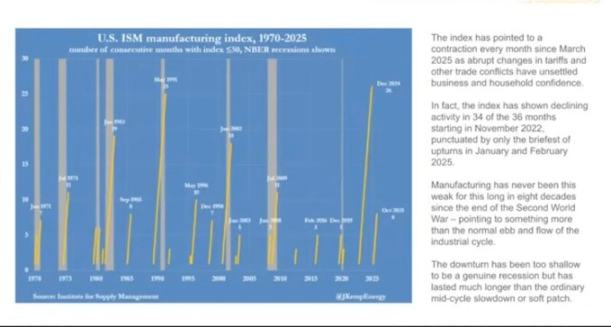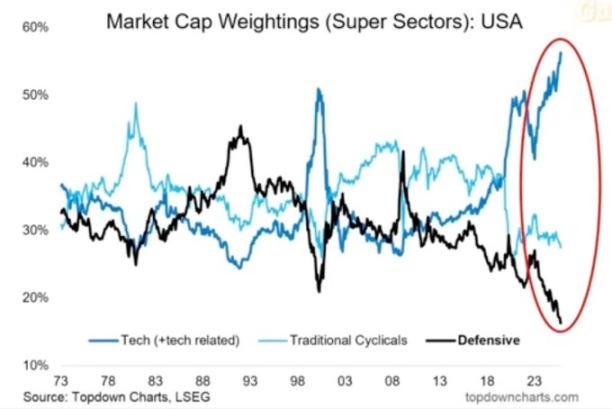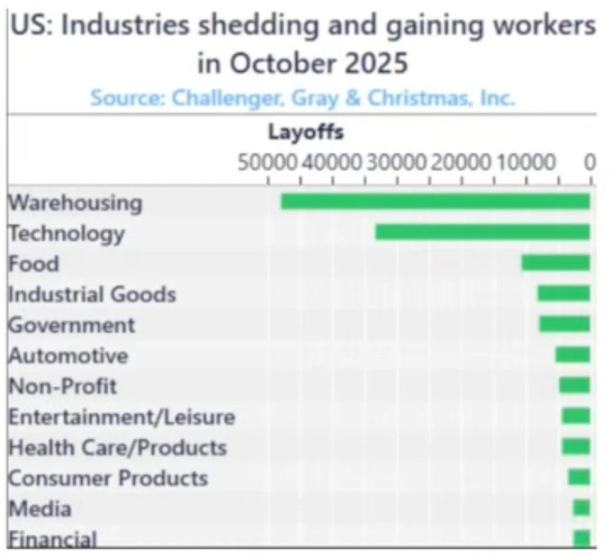When traditional financial markets fail, will the crypto industry become a "pressure relief valve" for liquidity?
The twilight of financialization: when debt cycles can only create nominal growth.
The Twilight of Financialization: When Debt Cycles Can Only Create Nominal Growth.
Written by: arndxt
Translated by: AididiaoJP, Foresight News
The U.S. economy has split into two worlds: on one side, financial markets are booming, while on the other, the real economy is slipping into a slow decline.
The Manufacturing PMI Index has contracted for over 18 consecutive months, marking the longest stretch since World War II, yet the stock market continues to rise as profits become increasingly concentrated among tech giants and financial companies. (Note: The full name of the "Manufacturing PMI Index" is "Manufacturing Purchasing Managers' Index," which serves as a "barometer" for the health of the manufacturing sector.)
This is essentially "balance sheet inflation."
Liquidity continuously drives up the prices of similar assets, while wage growth, credit creation, and small business vitality remain stagnant.
The result is economic bifurcation, where during recoveries or economic cycles, different sectors move in completely opposite directions:
On one side: capital markets, asset holders, the tech industry, and large corporations surge (profits, stock prices, wealth).
On the other side: wage earners, small businesses, blue-collar industries → decline or stagnate.
Growth and hardship coexist.
Policy Failure
Monetary policy can no longer truly benefit the real economy.

The Federal Reserve's rate cuts have pushed up stock and bond prices but have not brought about new jobs or wage growth. Quantitative easing has made it easier for large corporations to borrow, but it has not helped small businesses develop.
Fiscal policy is also nearing its limit.
Now, nearly a quarter of government revenue is used solely to pay interest on national debt.

Policymakers are thus caught in a dilemma:
Tighten policy to fight inflation, and the market stagnates; loosen policy to spur growth, and prices rise again. The system has become self-reinforcing: any attempt to deleverage or shrink the balance sheet will impact the asset values it relies on for stability.
Market Structure: Efficient Harvesting
Passive capital flows and high-frequency data arbitrage have turned the open market into a closed-loop liquidity machine.
Positioning and volatility supply have become more important than fundamentals. Retail investors have effectively become the counterparties to institutions. This explains why defensive sectors are abandoned, tech stock valuations skyrocket, and the market structure rewards momentum chasing rather than value investing.
We have built a market with extremely high price efficiency but extremely low capital efficiency.
The open market has become a self-reinforcing liquidity machine.
Funds flow automatically → through index funds, ETFs, and algorithmic trading → creating continuous buying pressure, regardless of fundamentals.
Price movements are driven by capital flows, not value.
High-frequency trading and systematic funds dominate daily trading, with retail investors essentially on the other side of the trades. Stock price movements depend on positioning and volatility mechanisms.
Thus, tech stocks continue to expand while defensive sectors lag behind.

Social Backlash: The Political Cost of Liquidity
Wealth creation in this cycle is concentrated at the top.
The wealthiest 10% hold over 90% of financial assets; the higher the stock market climbs, the wider the wealth gap becomes. Policies that drive up asset prices simultaneously erode the purchasing power of the majority.
With no real wage growth and unaffordable housing, voters will eventually seek change, either through wealth redistribution or political upheaval. Both options intensify fiscal pressure and drive up inflation.
For policymakers, the strategy is clear: maintain abundant liquidity, push up markets, and claim economic recovery. Use superficial prosperity to replace substantive reform. The economy remains fragile, but at least the data can hold until the next election.

Cryptocurrency as a Pressure Valve
Cryptocurrency is one of the few areas where value can be held and transferred without relying on banks or governments.
Traditional markets have become closed systems, with big capital capturing most of the profits through private placements before IPOs. For the younger generation, bitcoin is no longer just speculation but also an opportunity to participate. When the entire system seems manipulated, at least here there is still a chance.
Although many retail investors have been hurt by overvalued tokens and VC sell-offs, the core demand remains strong: people desire an open, fair, and self-controlled financial system.
Outlook
The U.S. economy cycles through "conditioned reflexes": tightening → recession → policy panic → liquidity injection → inflation → repeat.
The next round of easing may arrive in 2026, due to slowing growth and widening deficits. The stock market may experience a brief frenzy, but the real economy will not truly improve unless capital shifts from supporting assets to productive investment.
At present, we are witnessing the late-stage form of a financialized economy:
- Liquidity stands in for GDP
- The market becomes a policy tool
- Bitcoin becomes a societal pressure valve
As long as the system continues to turn debt cycles into asset bubbles, we will not see a true recovery—only slow stagnation masked by rising nominal figures.
Disclaimer: The content of this article solely reflects the author's opinion and does not represent the platform in any capacity. This article is not intended to serve as a reference for making investment decisions.
You may also like
Bitcoin’s “Silent IPO”: A Sign of Market Maturity and Future Implications

AiCoin Daily Report (November 15)
Surviving Three Bull and Bear Cycles, Dramatic Revival, and Continuous Profits: The Real Reason Curve Became the “Liquidity Hub” of DeFi
Curve Finance has evolved from a stablecoin trading platform into a cornerstone of DeFi liquidity through its StableSwap AMM model, veTokenomics, and strong community resilience, demonstrating a sustainable development path. Summary generated by Mars AI. The accuracy and completeness of this summary, generated by the Mars AI model, are still in the process of iterative improvement.


![[Bitpush Daily News Selection] Financial Times: Tether is considering leading a funding round of approximately $1.16 billion for German tech startup Neura Robotics; the US SEC has issued post-shutdown document processing guidance, and multiple crypto ETFs may be expedited; US Bureau of Labor Statistics: September 2025 employment data will be released on November 20, and October state employment and unemployment data will be released on November 21.](https://img.bgstatic.com/multiLang/image/social/06829a455cc5ced5cafaf4b9bf53d5281763243641786.png)